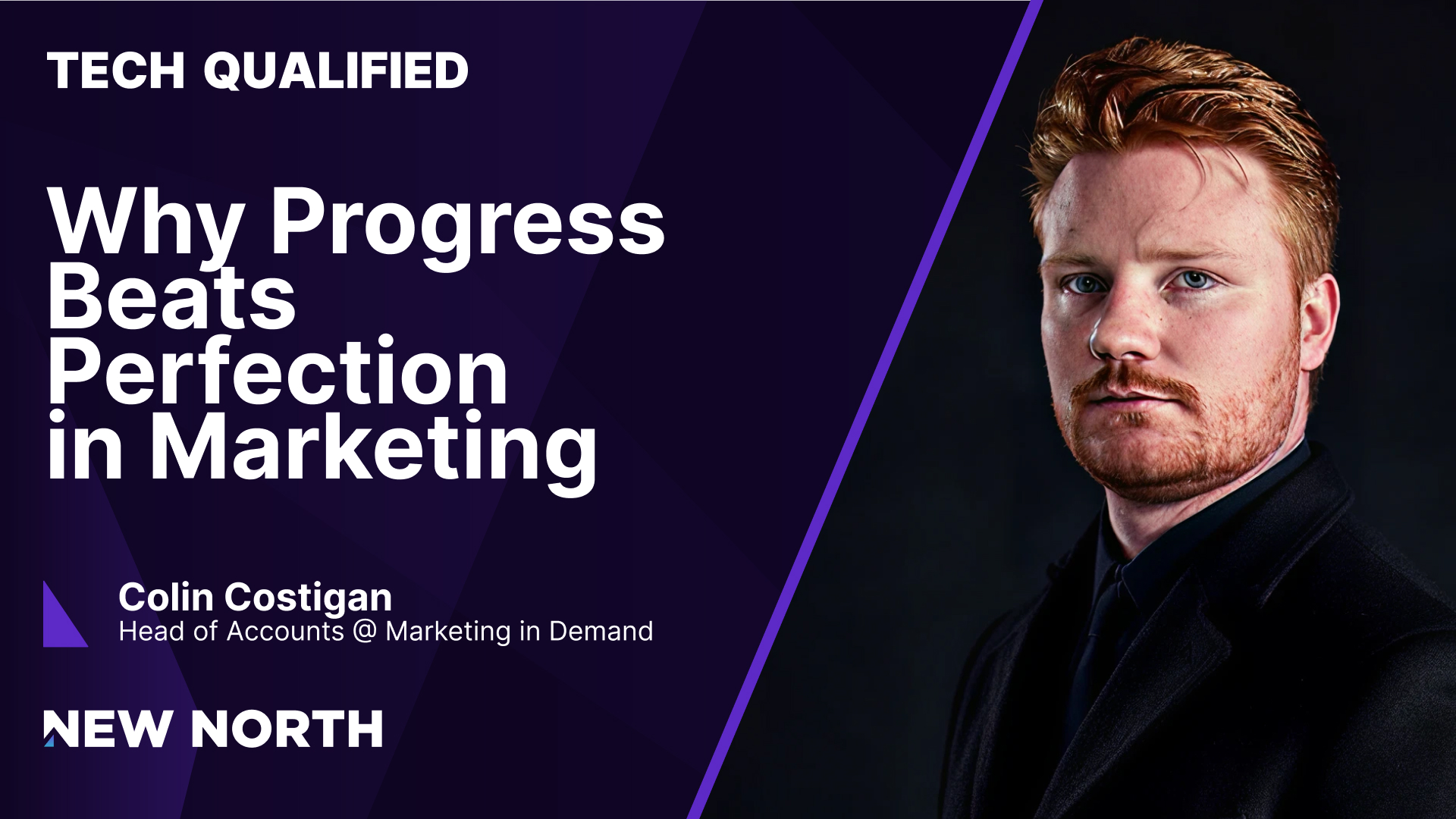Episode Summary
In this episode of Tech Qualified, host Baylee Gunnell joins Colin Costigan, Head of Accounts at Marketers in Demand, to discuss a common marketing challenge. Many teams want to launch a perfect campaign, but the market demands speed. Colin explains why perfection is unattainable and how teams can shift their thinking.
Colin suggests moving from an “architect” to an “engineer” mindset. Instead of endless planning, marketers should build, test, and gather real-world data. He advises treating every launch as a live experiment, not a final exam. This reframes failure as a learning opportunity and removes the pressure of a single, high-stakes release.
To build momentum, Colin advises a consistent cadence for reviewing data and launching new tests. This creates a continuous loop of learning and iteration. By focusing on progress, marketers can adapt faster and achieve better results in a constantly moving market.

Colin Costigan
Head of Accounts
Noteworthy: An advocate for iterative marketing who champions progress over perfection.

Key Insights
Adopt an Engineer’s Mindset for Faster Progress
Striving for a perfect marketing campaign often leads to paralysis. An architect can sketch plans forever, but an engineer knows nothing counts until you start building. This mindset shift is vital for modern marketing teams. Instead of waiting months to launch a polished campaign, treat every initiative as a buildable project. This approach encourages action and recognizes that real-world data is more valuable than internal whiteboard sessions. When your team stops planning for perfection and starts building for feedback, you gain velocity. You can quickly learn what works, what doesn’t, and what to test next. This practical, hands-on method allows you to adapt to market changes and stay ahead of competitors who are stuck in the planning phase.
Treat Every Launch as a Live Experiment
A launch should not feel like a final exam where failure means you are in trouble. Instead, view it as a live experiment designed to test a hypothesis. Your first version is simply a starting point, and you should be eager to see what data it produces. This perspective removes the emotional weight from the outcome. If a campaign element “cracks and everything fails,” it is not a disaster; it is valuable data. This information tells you what is valid and what is invalid in your approach, which is something you could never learn from theory alone. By reframing launches as testable experiments, the key question changes from “Is this perfect?” to “Is this testable?” This shift empowers teams to move faster and make decisions based on evidence.
Balance Your Risk Ceiling and Learning Floor
Launching quickly does not mean launching recklessly. You must define your “risk ceiling”—the critical issues that could break your campaign. These are non-negotiable elements like compliance, security, or brand messaging that accurately reflects your pricing. Once you clear these major risks, you can focus on the “learning floor.” Ask yourself: “If we launch this now, will it teach us something we can’t learn in the lab?” If the answer is yes, then it is time to go live. Any further delays become procrastination, not preparation. This framework creates a safe space to operate where critical risks are managed, and the primary goal is capturing new data. Every day your campaign is live becomes an opportunity to polish and learn, driving continuous improvement without jeopardizing your brand.
Create a Cadence for Continuous Improvement
Momentum comes from building a consistent habit of analysis and iteration. After a launch, you can collect data within hours, but truly viable data requires more time. Establish a regular cadence—weekly, bi-weekly, or monthly—to review performance and launch a new test. Holding your team accountable to this rhythm of “analyze and test” creates a powerful feedback loop. It transforms the marketing process into an effortless evolution toward a near-perfect campaign. This approach keeps your scope tight and your team aligned. Instead of waiting for a big reveal six months down the line, you celebrate small, incremental progress. Seeing a jump in engagement or a few conversions from a new landing page provides the motivation and data needed to inform the next decision.
Episode Highlights
The Modern Marketer’s Dilemma
Timestamp: [00:00:19]
In an era driven by AI and rapid technological change, there is immense pressure to move quickly. However, this push for speed often conflicts with the natural desire to produce polished, perfect work. This creates a constant balancing act between planning and launching. Marketers must navigate these two competing forces to find a sustainable and effective workflow. The discussion explores how teams can shift their mindset to embrace this dynamic environment without succumbing to analysis paralysis or sacrificing quality.
“I feel like we live in a really interesting era right now where there’s expectations for us to move so fast, and especially with AI, we can move really fast. But then there’s also the other side of wanting perfection or wanting things to be really, really good before we launch. So I feel like we’re kind of balancing these two different sides of the coin.”
Mitigating Risk with Smart Segmentation
Timestamp: [00:04:42]
Marketers often hesitate to launch quickly due to fears about budget waste and brand reputation. Baylee raises these common objections, and Colin Costigan offers a practical solution. Instead of launching a new campaign to your entire audience, you can select a small, specific segment to test with. This approach allows you to gather real-world data and validate your ideas without blowing your entire budget or risking negative feedback from your whole customer base. It is a scrappy, low-risk way to get things launched. This strategy effectively protects your brand’s reputation while still allowing for the rapid testing needed to find what works.
“You don’t have to spend a lot of budget to just get things launched. You can start small, test, and then expand your budget as things start to work. You also don’t have to launch campaigns to your entire audience. You can pick a small segment, test things with them, and still keep your brand reputation really good.”
Resisting the “Judgment Day” Mentality
Timestamp: [00:07:13]
Teams often resist rapid launches because the act of going live can feel like a final judgment. After getting approval and investing time, there is a fear that if the campaign does not work immediately, the team is in trouble. This pressure creates a desire to stay on the whiteboard, trying to perfect every variable. However, this approach is flawed because real people in real environments will always expose unexpected issues. To overcome this, Colin suggests reframing the launch not as a final product but as “opening a beta” to collect essential data from an audience that doesn’t know your product as well as you do.
“I think teams resist it because when you launch something, it almost feels like judgment day. You’re like, ‘All right, I finally got approval to get this thing live, and if this doesn’t work right away, I’m in trouble.’ It might not only be trouble you feel with your leadership, but with how users are going to resonate with all of the messaging.”
Remove Emotion from the Data
Timestamp: [00:10:50]
When an imperfect launch does not go as planned, the key is to respond with logic, not emotion. As creative people, marketers can become personally attached to the messaging they wrote or the landing page they built. However, data from a successful test is just as useful as data from one that did not perform well. You need to know what works and what doesn’t. The best response is to stick to the facts: what actually happened and what did you learn? By removing personal feelings, you can pinpoint the one thing that needs fixing instead of changing ten things at once, which obscures what truly made an impact.
“We’re creative people, right? We use a lot of data, and it’s an interesting mix, but we need to take away our personal feel to that messaging we wrote or that landing page we built that we felt so proud of. And just stick to the facts. So, what actually happened? What went wrong? What did we learn?”
